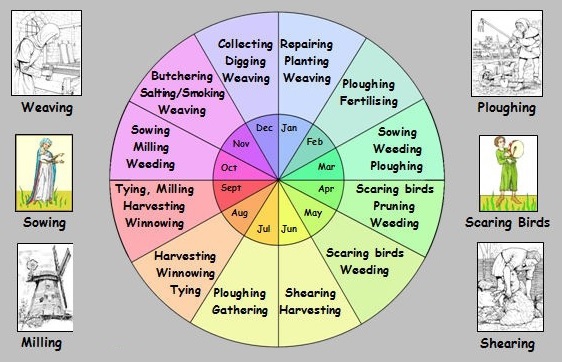Agriculture (technology)
Agriculture is the process of cultivating soil, planting and harvesting crops. The technology establishes the fixed agrarian society, the single most important step towards creating a civilisation. Storage of grains, pulses, tubers and vegetables ensures a stable food supply for a larger number of people than either fishing or hunting and gathering.
Like all technologies, agriculture is distinguished by its techniques, processes and societal relationships. The page below describes the technology according to its sub-technologies (shown as minor headings). Details are further classified into tools, culture, blocks, improvements and associated references.
Contents
DEV-6
Primitive Agriculture
The domestication of plants consists of the gathering of wild grains, tubers, pulses, vegetables and other crop species, while creating techniques to allow sustainable farming. The amount of food grown allows only enough for the immediate workers, as yields per parcel of land are very low. To protect the land against predation or erosion, low broken-stone walls are built. To some extent, the population continues to support its food supply through hunting and fishing.
- Tools: (made of hemp/stone/wood): flail, hand mill, hoe, mortar & pestle, scythe, sickle, winnower
- Ard plough: a scratch plough without a mouldboard, resembling a hoe which is dragged through the soil by draft animals and very rarely by people.
- Blocks: large areas depicting cultivated fields (without fallow), gardens and orchards.
- Improvements
- Farmlands: rich soils enabling tilled lands to produce higher yields of stable grains and other crops. May exist in up to two T(1-5) rural hexes per reference. Adds +1 food.
- References: cereals grains, fruits, pulses, seed crops, vegetables
- Health foods: mustard seed (+1 health)
- Luxury crops: coffee, sugar, tobacco, wine (+1 happiness)
- Refined foodstuffs: flour, seed oil, starch, sugar
Homesteading
The forming of permanent conglomerations allows for a sedentary, sustained population, though usually isolated and lacking in civil engineering or planning. These hamlets or villages are able to organize themselves for the public welfare of all its residents. There is no indepedent ownership of land and food that is preserved is set aside for the survival of all.
- Tools: thatch roofs
- Culture
- The Village: the yearly seasonal cycle creates patterns of living, promoting communities where the villagers have a common goal. The need to protect fields against animal and outsiders draws residents together. Land disputes are settled by a Council of Elders, selected by age, charisma and achievement. The sedentary pattern of life assures the presence of neighbors and the spread of gossip, so that what happens quickly becomes known to all. Seasonal festivals follow moments when joint effort and reward is important, and this brings happiness.
- Blocks (from smallest to largest)
- Thorpe: a tiny rural centre of 3-9 buildings, scattered but within a minute's walk of one another, lacking services.
- Hamlet: three times the size of a thorpe (9-27 buildings), with loosely clustered houses occasionally touching yards, with residents sharing natural resources.
- Dispersed village: settlement of more than 100 persons, shaped like an extended thorpe, with dwellings following the terrain. Home access to main settlement, rivers and water bodies is inconsistent. Independently located farms.
- Linear village: settlement typically ranging from 200-500 persons, following a river or lane in a linear fashion, with adjoining rear yards giving direct access to water sources. Juxtaposing farms will begin at the settlement's edge.
- Open space village: settlement typically ranging from 400-900 persons, criss-crossed with winding lanes and a few main roads. Adjoining yards and walls provide some closeness, but intermittent gardens and some fields space the houses sufficiently to remove the sense of an enclosed town. Low walls between yards are common but do not act as barriers. Considerable sharing of resources and defenses; the village centre includes a well-tended park-like greenspace.
- Country town: settlement typically ranging from 800-2400 persons, with organized roads and one main avenue accessing the town centre. Many high rock walls between wealthier houses and some homes built within a few yards of one another. Many fields and gardens are still located within the town, so that small neighborhoods are spaced. Includes a palisade if located within 20 miles of a border.
- Closed town: settlement typically ranging from 2000-5000 persons, with adjacent houses and small yards, often built on hills or other defensible terrain. The residents will follow many specialty occupations, encouraging manufactures. Food consumption is high. Always protected by a palisade and some wooden towers.
- Closed city: like a closed town, with more than 5000 persons.
DEV-7
Irrigation
A means of manipulating the distribution of water on alluvial plains through the coaxing of water through a matrix of small channels formed in fields. This enables exploitation of otherwise dry arable lands, increasing the scale of local farming. Irrigation enables water-storage strategies such as cisterns and reservoir ponds.
- Tools
- Saqiyah: a mechanical water-lifting device using buckets, jars or scoops attached to a vertical wheel, powered by animals.
DEV-8
Manorial System
An organizing principle of rural economies which vested legal and economic power in the hereditary lord of the manor. The lord was supported economically from the direct landholding in a manor (later a fief). The manor imposed an open field system that improved the organisation of labor, and thereby improving the food production and particularly the economic value of agricultural production.
- additional manorial system content to follow
Higher Development
- Carruca (iron working)
- Waterwheel (machinery)
- Horse collar (feudalism)
- Well (see masonry)

